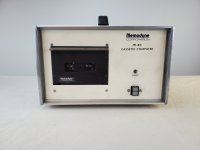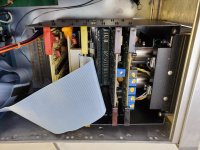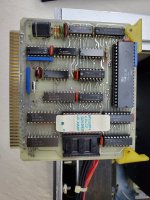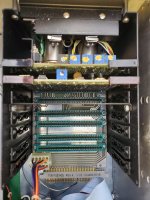falter
Veteran Member
I bought this a long time ago and posted it here. Originally was thinking it was just a fancy digital cassette recorder, however subsequent Googlings proved it to be a ruggedized Z80 computer from the late 70s.
The interior is in excellent condition and it powers up without issue. However, despite supposedly working with a serial terminal, it does not seem to respond to any terminal connected to it. I've connected a breakout box and there are no signals at all coming out of either serial port, once of which is db25 male and the other db25 female. I've taken a guess that the male port, which is labelled J1, is the primary serial port. So far voltages check out okay. I haven't gotten to scope it yet it has a very small and tight card cage that is impossible to get the probes into. Need to create some kind of extender card.
According to documentation the machine can operate in a 'recording mode' or in a 'computer mode'. I am sort of suspecting that this machine may be waiting for a key sequence to kick over to computer mode. In the only documentation of any kind I've found describing operation, on a slightly different model with keys on the front, it says hitting Shift-FWD will enter computer mode. I'm thinking maybe there's a key sequence on a terminal that does the same?
I've dumped the EPROM and then I ran it through a disassembler.. I don't really understand what's going on there but I was wondering if anyone familiar with Z80 code might be able to pinpoint any input it's waiting for.
Many thanks!
The interior is in excellent condition and it powers up without issue. However, despite supposedly working with a serial terminal, it does not seem to respond to any terminal connected to it. I've connected a breakout box and there are no signals at all coming out of either serial port, once of which is db25 male and the other db25 female. I've taken a guess that the male port, which is labelled J1, is the primary serial port. So far voltages check out okay. I haven't gotten to scope it yet it has a very small and tight card cage that is impossible to get the probes into. Need to create some kind of extender card.
According to documentation the machine can operate in a 'recording mode' or in a 'computer mode'. I am sort of suspecting that this machine may be waiting for a key sequence to kick over to computer mode. In the only documentation of any kind I've found describing operation, on a slightly different model with keys on the front, it says hitting Shift-FWD will enter computer mode. I'm thinking maybe there's a key sequence on a terminal that does the same?
I've dumped the EPROM and then I ran it through a disassembler.. I don't really understand what's going on there but I was wondering if anyone familiar with Z80 code might be able to pinpoint any input it's waiting for.
Many thanks!




